Feral pigeon
| Feral domestic rock pigeon | |
|---|---|
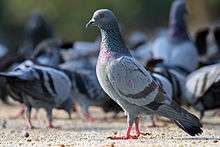 | |
| Feeding in a park | |
| Scientific classification | |
| Kingdom: | Animalia |
| Phylum: | Chordata |
| Class: | Aves |
| Order: | Columbiformes |
| Family: | Columbidae |
| Genus: | Columba |
| Species: | C. livia |
| Subspecies: | C. l. domestica |
| Trinomial name | |
| Columba livia domestica Gmelin, 1789[1] | |
| Synonyms | |
|
Columba livia rustica | |
Feral pigeons (Columba livia domestica), also called city doves, city pigeons, or street pigeons, are derived from domestic pigeons that have returned to the wild.[2] The domestic pigeon was originally bred from the wild rock dove, which naturally inhabits sea-cliffs and mountains.[3] Rock (i.e., 'wild'), domestic, and feral pigeons are all the same species and will readily interbreed. Feral pigeons find the ledges of buildings to be a substitute for sea cliffs, have become adapted to urban life, and are abundant in towns and cities throughout much of the world.[4]
Breeding
Breeding system
According to the current belief that doves mate for life, wild, domestic and feral pigeons form long-term bonds, although not unbreakable ones.[5] They are socially monogamous, but extra-pair matings do occur, often initiated by males.[6]
Courtship

Courtship rituals can be observed in urban parks at any time of the year. The male on the ground or rooftops puffs up the feathers on his neck to appear larger and thereby impress or attract attention. He approaches the hen at a rapid walking pace while emitting repetitive quiet notes, often bowing and turning as he comes closer.
At first, the female invariably walks or flies a short distance away and the male follows her until she stops. At this point, he continues the bowing motion and very often makes full- or half-pirouettes in front of the female. The male then proceeds to feed the female by regurgitating food, as they do when feeding the young.
The male then mounts the female, rearing backwards to be able to join their cloacae. The mating is very brief with the male flapping his wings to maintain balance on top of the female.
Nesting
Abandoned buildings are favourite nesting areas. Mass nesting is common as pigeons are a community flocking bird; often, dozens of birds share a building. Loose tiles and broken windows provide access, and pigeons are adept at spotting new access points, for example following property damage caused by strong winds.
Nests and droppings tend to stay clustered and remain dry when out of the weather. Pigeons are particularly fond of roof spaces. These often contain water tanks. Any water tank or cistern on a roof must, therefore, be secured and sealed off to keep the pigeons out of them. The popularity of a nesting area does not seem to be affected by the pigeons' population density.
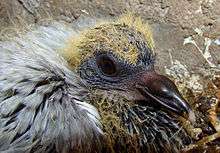
On undamaged property, the gutters, window air conditioners and empty air conditioner containers, chimney pots, and external ledges are used as nesting sites. Many building owners try to limit roosting by using bird control spikes and netting to cover ledges and potential nesting places on buildings. This has little effect on the size of the pigeon population, but it can reduce the accumulation of droppings on and around a particular building location.
In the UK, only the larger and more wary common wood pigeon, which often shares the same territory and food supply, builds nests in trees, usually close to roads.
Cooing
In Wendell Levi's The Pigeon, he describes the crowing/cooing of pigeons as mostly being associated with strutting and fighting in male birds.[3] Hens also coo, but this is noticeably less guttural than the cooing of the cock. Cooing is also more frequent between couples during mating and nesting.
Both parents participate in the incubation of the eggs.
Food
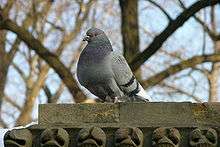
Pigeons breed when the food supply is abundant enough to support embryonic egg development, which in cities can be any time of the year. Laying of eggs can take place up to six times per year.
Pigeons are often found in pairs during the breeding season, but usually the pigeons are gregarious, living in flocks of 50 to 500 birds (dependent on the food supply).[7]
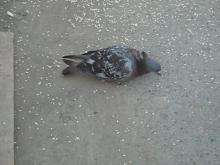
Feral pigeons can be seen eating grass seeds and berries in parks and gardens in the spring, but plentiful sources exist throughout the year from scavenging (e.g., remnants left inside of dropped fast-food cartons) and they also take insects and spiders. Additional food is also usually available from the disposing of stale bread in parks by restaurants and supermarkets and from tourists buying and distributing birdseed, etc. Pigeons tend to congregate in large, often thick flocks when feeding on discarded food, and have been observed flying skillfully around trees, buildings, telephone poles, and cables, and even through moving traffic just to reach a food source.
City Squares famous for pigeons
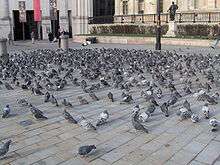
Many city squares have large pigeon populations, such as the Piazza San Marco in Venice, The Gateway of India in Mumbai and Trafalgar Square in London - although measures are now taken to deter pigeons in Trafalgar Square.[8]
Killing or injuring pigeons
In the UK Pigeons are covered under the 'General Licences' https://www.gov.uk/government/collections/bird-licences) and can be humanely culled by the land owner or their agent for a variety of reasons (mainly crop protection). It is not legal to kill/destroy nests for any other reason other than those listed under the general licences.
Population control

Feral pigeons often only have small populations within cities. For example, the breeding population of feral pigeons in Sheffield, England, has been estimated at only 12,130 individuals.[9] Despite this, feral pigeons usually reach their highest densities in the central portions of cities, so they are frequently encountered by people, which leads to conflict.
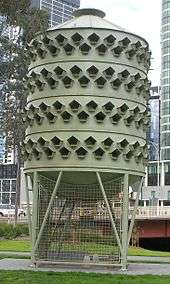

Feral pigeons are often considered a pest or even vermin, owing to concerns that they spread disease[10] and are much maligned in the media for transmitting bird flu, but it has been shown pigeons do not carry the deadly H5N1 strain. It is rare that a pigeon will transmit a disease to humans due to their immune system. Three studies have been done since the late 1990s by the US Agriculture Department's Southeast Poultry Research Laboratory in Athens, Georgia, according to the center's director, David Swayne. The lab has been working on bird flu since the 1970s.
In one experiment, researchers squirted into pigeons' mouths liquid drops that contained the highly pathogenic H5N1 virus from a Hong Kong sample. The birds got 100 to 1,000 times the concentration that wild birds would encounter in nature. "We couldn't infect the pigeons," Swayne said. "So that's good news."[11][12]
The bacteria Chlamydophila psittaci is endemic among pigeons[13] and causes psittacosis in humans. It is transmitted both from handling pigeons but mostly from their droppings. Psittacosis is a serious disease but rarely fatal (less than 1%). Pigeons are also important vectors for different species of the bacteria Salmonella,[14][15] which causes diseases as salmonellosis and paratyphoid fever.
There is ample reason for the concerns of pigeons damaging property, due to their size and proximity to people and their dwellings. Pigeons often cause significant pollution with their droppings, though there is little evidence of them driving out other bird species. Pigeons are labeled an invasive species in North America by the USDA.[16]
Long-term reduction of feral pigeon populations can be achieved by restricting food supply, which in turn involves legislation and litter (garbage) control. Some cities have deliberately established favorable nesting places for pigeons—nesting places that can easily be reached by city workers who regularly remove eggs, thereby limiting their reproductive success.[17] In addition, pigeon populations may be reduced by bird control systems that successfully reduce nesting sites.
Peregrine falcons and other urban predators
Peregrine falcons, which are also originally cliff dwellers, have also adapted to the skyscrapers of large cities and often feeding exclusively on rock pigeons.[18] Some cities actively encourage this through falcon breeding programs. Projects include Unibase Falcon Project and the Victorian Peregrine Project.
Larger birds of prey occasionally take advantage of this population as well. In New York City, the abundance of pigeons (and other small animals) has created such a conducive environment for predators that the red-tailed hawk has begun to return in very small numbers, the most famous of which is Pale Male.
In Wrexham, Wales, a pair of peregrine falcons has nested since 2002.[19][20]
Poison
Due to their non-selective nature, most avian poisons have been banned. In the United States market only 4-aminopyridine (Avitrol) and DRC-1339 remained registered by EPA. DRC-1339 is limited to USDA use only while 4-AP is a restricted use pesticide, for use only by licensed applicators.
The use of poisons has been proven to be fairly ineffective, however, as pigeons can breed very quickly—up to six times a year—and their numbers are determined by how much food is available; that is, they breed more often when more food is provided to them.
When pigeons are poisoned, surviving birds do not leave the area. On the contrary, they are left with more food per bird than before. This attracts pigeons from outside areas as well as encouraging more breeding, and populations are re-established quickly.[21] An additional problem with poisoning is that it also kills pigeon predators. Due to this, in cities with peregrine falcon programs it is typically illegal to poison pigeons.[18]
Reducing food supply
A more effective tactic to reduce the number of feral pigeons is deprivation.[22] Cities around the world have discovered that not feeding their local birds results in a steady population decrease in only a few years. Pigeons, however, will still pick at garbage bags containing discarded food or at leftovers carelessly dropped on the ground. Feeding of pigeons is banned in parts of Venice, Italy.[23]
Avian contraceptives
In 1998, in response to conservation groups and the public interest, the National Wildlife Research Center (NWRC), a USDA/APHIS laboratory in Fort Collins, Colorado, started work on nicarbazin, a promising compound for avian contraception. Originally developed for use in resident Canada geese, nicarbazin was introduced for use as a contraceptive for feral pigeons in 2007.
The active ingredient, nicarbazin, interferes with the viability of eggs by binding the ZP-3 sperm receptor site in the egg.[24] This unique contraceptive action is non-hormonal and fully reversible.[25]
Registered by the EPA as a pesticide (EPA Reg. No. 80224-1), "OvoControl P", brand of nicarbazin, is increasingly used in urban areas and industrial sites to control pigeon populations. Declared safe and humane, the new technology is environmentally benign[26] and does not represent a secondary toxicity hazard to raptors or scavengers.[27]
Avian contraception has the support of a range of animal welfare groups including the Humane Society of the United States (HSUS), the American Society for the Prevention of Cruelty to Animals (ASPCA) and People for the Ethical Treatment of Animals (PETA).
Dummy egg nesting
When eggs are removed in artificial pigeon houses, the interval between reproductive attempts is strongly reduced, which reduces the efficiency of the method.[28] Dummy egg nesting programs have therefore been tested in some cities with mixed results. There, the eggs are removed and replaced with dummy eggs. The real eggs are then destroyed. Such structures are being used in New York City and also the Melbourne city centre by the Melbourne City Council at Batman Park[29][29][30] The loft used in Melbourne is on stilts, with a cage door allowing access from beneath for accessing the structure at night when the pigeons are asleep.
See also
| Wikimedia Commons has media related to Columba livia. |
References
- ↑ "Columba livia Gmelin, 1789" (Web data). ITIS Report. Retrieved 2008-02-26.
- ↑ "Science & Nature: Animals: Feral Pigeon" (Web article). BBC.CO.UK. Retrieved 2008-01-05.
- 1 2 Levi, Wendell (1977). The Pigeon. Sumter, S.C.: Levi Publishing Co, Inc. ISBN 0-85390-013-2.
- ↑ "Why study pigeons? To understand why there are so many colors of feral pigeons." (Web Article). Cornell Lab of Ornithology. Retrieved 2008-01-06.
- ↑ Marchesan, M. (2002). "Operational sex ratio and breeding strategies in the Feral Pigeon Columba livia.". Ardea 90 (2): 249–57.
- ↑ Lovell-Mansbridge, C.; Birkhead, T.R. (1998). "Do female pigeons trade pair copulations for protection?". Animal Behaviour 56 (1): 249–57. doi:10.1006/anbe.1998.0774.
- ↑ Gibbs, David; Barnes, Eustace; Cox, John. Pigeons and Doves: A Guide to the Pigeons and Doves of the World. United Kingdom: Pica Press. p. 624. ISBN 1-873403-60-7.
- ↑ Bird control contractor appointed in 2004 to deter pigeons from Trafalgar Square, vvenv.co.uk, 8 October 2004, retrieved 1 May 2015
- ↑ Fuller, R.A.; Tratalos, J.; Gaston, K.J. (2009). "How many birds are there in a city of half a million people?". Diversity and Distributions 15 (2): 328–337. doi:10.1111/j.1472-4642.2008.00537.x.
- ↑ "Facts about pigeon-related diseases" (Web article). The New York City Department of Health and Mental Hygiene. Retrieved 2008-01-04.
- ↑ Turner, Brad. "Avian flu virus H5N1 and pigeons: the facts." (Web article). Purebred Pigeon Magazine. Retrieved 2008-01-04.
- ↑ Panigrahy, B.; Senne, D.A.; Pedersen, J.C.; Shafer, A.L.; Pearson, J.E. (1996). "Susceptibility of pigeons to avian influenza". Avian Dis. (American Association of Avian Pathologists, Inc.) 40 (3): 600–4. doi:10.2307/1592270. JSTOR 1592270. PMID 8883790.
- ↑ Ila Geigenfeind, Daisy Vanrompay & Daniel Haag-Wackernagel (February 2012). "Prevalence of Chlamydia psittaci in the feral pigeon population of Basel, Switzerland". Journal of Medical Microbiology 61 (Pt 2): 261–265. doi:10.1099/jmm.0.034025-0. PMID 21921110.
- ↑ Antonio Gargiulo, Tamara Pasqualina Russo, Rita Schettini, Karina Mallardo, Mariarosaria Calabria, Lucia Francesca Menna, Pasquale Raia, Ugo Pagnini, Vincenzo Caputo, Alessandro Fioretti & Ludovico Dipineto (April 2014). "Occurrence of enteropathogenic bacteria in urban pigeons (Columba livia) in Italy". Vector borne and zoonotic diseases (Larchmont, N.Y.) 14 (4): 251–255. doi:10.1089/vbz.2011.0943. PMID 24661012.
- ↑ Kamelia M. Osman, Mona Mehrez, Ahmed M. Erfan & AlAtfeehy Nayerah (May 2013). "Salmonella enterica isolated from pigeon (Columba livia) in Egypt". Foodborne pathogens and disease 10 (5): 481–483. doi:10.1089/fpd.2012.1347. PMID 23531124.
- ↑ Paulik, Laurie. "Pigeons" (Web article). AgNIC Wildlife Damage Management. Retrieved 2008-01-04.
- ↑ Blechman, Andrew (2007). Pigeons-The fascinating saga of the world's most revered and reviled bird. St Lucia, Queensland: University of Queensland Press. ISBN 978-0-7022-3641-9.
- 1 2 Kleinman, Rachel (2007-10-19). "Fastest bird on earth enjoys family time high above city street". The Age (Melbourne).
- ↑ "Eyes in the sky". BBC News. 2010-06-16.
- ↑ Nick - Web Team (2009-06-24). "Natural selection on the roof of Wrexham police station". North East Wales Weblog:. BBC. Retrieved 2012-08-29.
- ↑ Blechman, Andrew (2007). Pigeons-The fascinating saga of the world's most revered and reviled bird. St Lucia, Queensland: University of Queensland Press. ISBN 978-0-7022-3641-9. Archived from the original on 2008-01-12.
- ↑ Feral Pigeons in Bexley Archived September 28, 2007 at the Wayback Machine
- ↑ The New York Times - Breaking News, World News & Multimedia
- ↑ Reinoso, V., A. MacDonald and G.F. Barbato. Nicarbazin reduces egg production and fertility in White Pekin Ducks. Accepted for publication in Poultry Science.
- ↑ Avery, M., K. Keacher, and E. Tillman. Nicarbazin bait reduces reproduction by pigeons (Columba livia). 2008. Wildlife Research 35(1) 80-85
- ↑ EPA Fact Sheet: Nicarbazin http://wayback.archive.org/web/20120625211506/http://www.epa.gov/opprd001/factsheets/nicarbazin.pdf
- ↑ http://wayback.archive.org/web/20100525063920/http://ovocontrol.com/wp-content/uploads/2010/03/Secondary-Toxicity-of-Nicarbazin-in-Birds.pdf
- ↑ Jacquin, L.; Cazelles, B.; Prévot-Julliard, A.-C.; Leboucher, G.; Gasparini, J. (2010). "Reproduction management affects breeding ecology and reproduction costs in feral urban Pigeons (Columba livia).". Canadian Journal of Zoology 88 (8): 781–7. doi:10.1139/Z10-044.
- 1 2 "'Rats with wings': a history of the urban pigeon - Rear Vision - ABC Radio National (Australian Broadcasting Corporation)". Abc.net.au. Retrieved 2012-08-29.
- ↑ http://wayback.archive.org/web/20090318005446/http://www.melbourne.vic.gov.au/opm/bc/CTEE/meetings/CSCaCD_51_20040907.pdf
Books
- Levi, Wendell (1977). The Pigeon. Sumter, S.C.: Levi Publishing Co, Inc. ISBN 0-85390-013-2.
- Johnston, Richard F.; Janiga, Marián (1995). Feral Pigeons. Oxford University Press. ISBN 978-0-19-508409-2.
